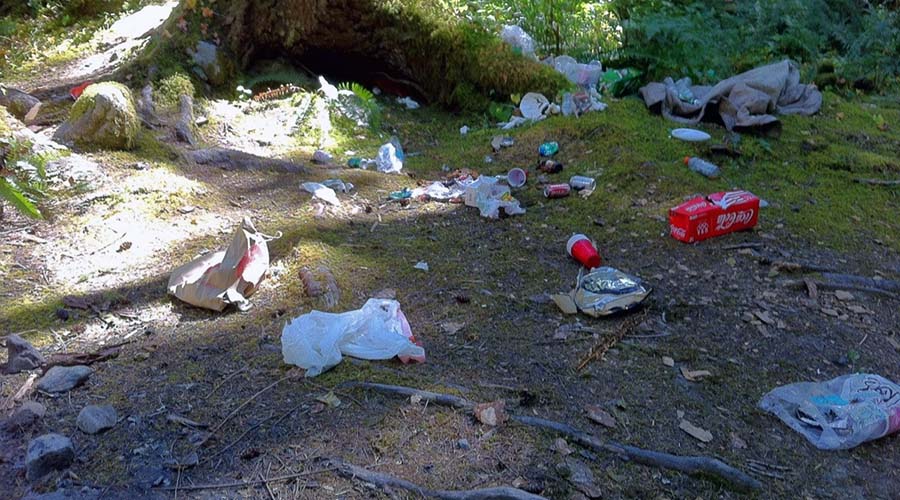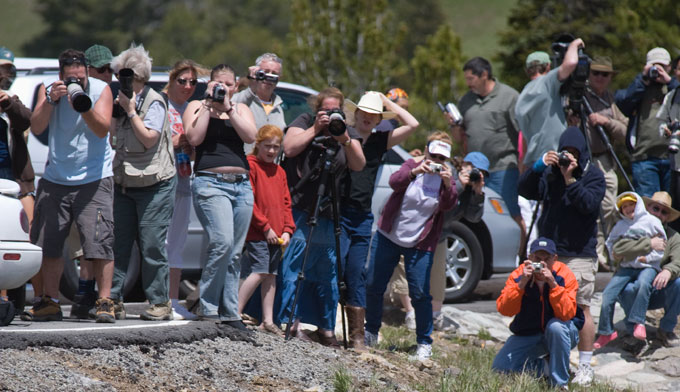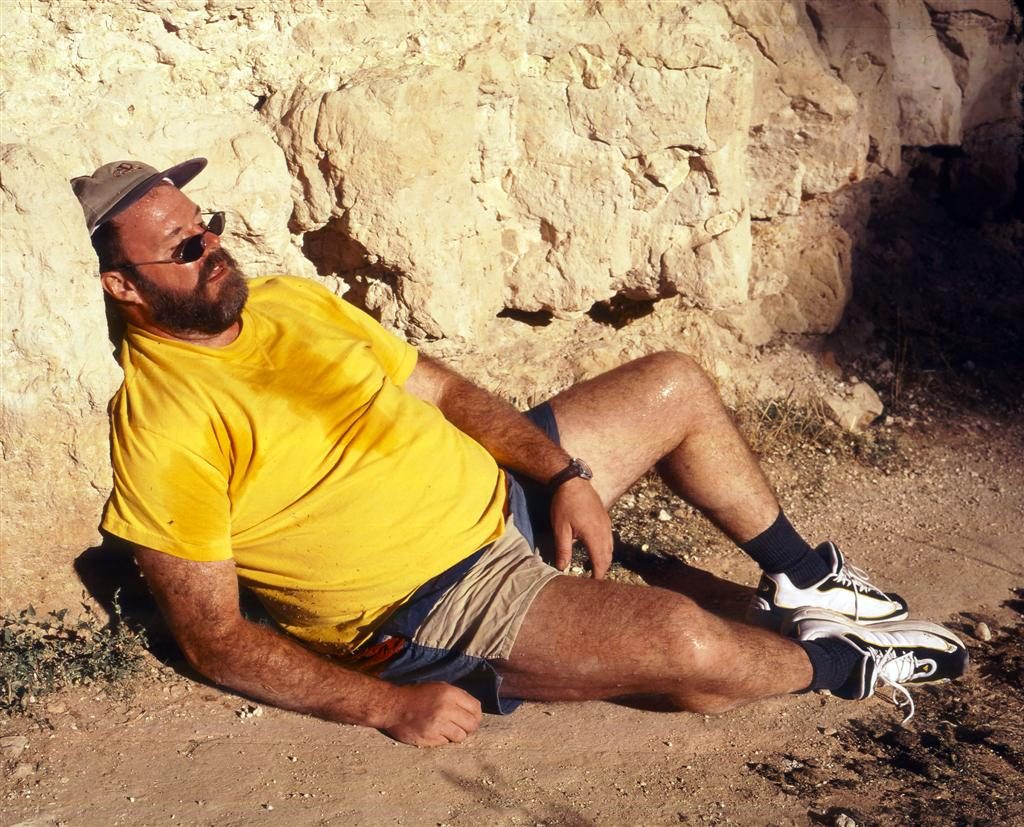“Fear the goat from the front, fear the horse from the rear, and man from all sides.”
Old Assyrian proverb.

Their minivan parks along the curb of Laurel Falls, mom slides the door open and out spill the kids armed with juice boxes, apple slices, grandma and the dog. Dad hands mom a couple of bottles of water, some wet wipes to throw in her purse and opens his map of trails within the Smoky Mountains National Park. Flip flops, t shirts and shorts are the popular dress, with an occasional hiker geared in sturdy boots and a backpack.The sign near the entrance says no dogs allowed on the trails but as the day unfolds that appears to be just a suggestion.
It’s early Saturday morning and the parking lot is already jammed. The hike is less than 3 miles round trip on a paved yet sometimes narrow and steep trail with sharp drop offs and uneven paths. It isn’t uncommon to see discarded water bottles, snack wrappers, even an occasional beer can.The two rangers we run into are summer help, and their job today is to scale a 70′ drop using a harness and a rope tied to a tree, and retrieve garbage. They are young and enthusiastic, but it is apparent that there is a growing disdain for the lack of concern a large segment of the trails visitors have for the work required to preserve the wildlife and ecosystem. Despite the difficulty of the trail, we pass a woman with her son, pushing her elderly mother past us in a wheel chair. A beautiful malamute appears ahead of us, his leash dragging as he skips along tongue spilling out the side of his head. 40 yards behind the dog two 20 something guys come around a corner of the trail engaged in chatter not immediately realizing their dog is out of sight. We exchange “hellos” as we pass by. “Digger!” one of them shouts out as the other whistles.
FYI, people don’t know your dog and not everyone likes dogs. Dogs bark and disturb wildlife.If a dog goes after a wolf or bear it will likely lose. You will risk injury or attack trying to defend your dog, but ultimately no matter who is to blame, bears are typically put down after contact. They die because of your dog, your trash, your selfie.
Even the scent from garbage or your campsite can “food condition” bears and wild animals. They’ll quickly equate a meal with you and the effect is irreversible, and terminal.
Meanwhile, at the falls, we are wading thru easily a hundred other tourists. At east a dozen have climbed the falls, milling around 80′ above, shouting down to their friends. Young girls sunbathe in bikinis. A small wooden bridge overlooking rock formations below is packed with hikers on both sides. As we move to the side of a plateau, a women passes by us, her face pushed into her IPhone. Wearing just sandals, she slips on a patch of algae, her phone going straight up into the air. She lands hard on her back, laying stunned while onlookers lean over to see if she is ok. It is several minutes before she is able to stand, however her phone doesn’t fare so well, submerged in a puddle nearby. Nearby a local Tennessean with a heavy twang stands wondering out loud “How can so many people be unprepared and unsupervised in one place without getting hurt?”
Similar examples are evident from the Appalachian trail to Yellowstone to the Grand Canyon. As more and more crowd into these landmarks, indifference is evident by the refuse, the graffiti and vandalism.  Baiting animals with food in order to take a photograph has become common; traffic jams become common as the occupants of the lead car jump out and chase a moose into the woods.
Baiting animals with food in order to take a photograph has become common; traffic jams become common as the occupants of the lead car jump out and chase a moose into the woods.
The yearly average of deaths inside National Parks is around 140 people. Based on 280 million annual visitors that doesn’t seem extreme; the damage from the latter is however.
Drowning is the leading cause and has risen from 32 in 2007 to nearly 60 in 2013.
170 people have slipped/fallen or otherwise gone over the edge over mountains and cliffs in the same period and died.
For so many parks noted for their hiking trails and secluded beauty, distracted driving accounted for 27% of the fatalities.Dig a little deeper and you’ll find 23% of the time alcohol was involved, and another 14% were killed due to driving on the wrong side of the road.
The Demographics? Those between 20-29 and 50-59 account for more than half the deaths. Men are 3 times more likely to die than women, and believe it or not, they aren’t all Americans. German, Italian, Japanese, Mexican and Canadian tourists come in behind the US.
10% of the search and rescues occur on Tuesday, making it the safest day to venture out.
Animal attacks do occur, though not with the frequency the media may lead you to believe, and they aren’t always from bears. It isn’t difficult to come up on a startled and poisonous snake, and in 2010 a 63 year old hiker along a trail in Olympic National Park after he was attacked by a mountain goat. 
The lack of preparedness and awareness by the general public is stunning. In an electronic age, everything seems reachable. The mountains should have handrails, the wilderness a road. It isn’t tv. Places like Skyline Drive and Cades Cove give vacationers a “Drive Thru Window” and a convenient serving of the wild from the heated seats of their SUV.
According to Linda Miller Yellowstone Public Affairs Officer, the park averages three life flights per day during the summer months, mainly due to car accidents and health issues.
In a case where warning signs do little more than block the road, an intensive S&R (search and rescue) was undertaken in the North Rim of the Grand Canyon recently, when a man and woman from Pennsylvania rented a car and drove past the road closed barriers until becoming stuck in snow along a logging road. The woman walked 26 miles before collapsing in a vacant ranger station. Fortunately everyone survived but at a massive cost and risk to those involved in finding them.
Bright Angel Trail is a awe inspiring trail that descends over 4000′ from the south rim for almost 9 1/2 miles. It typically can take 4-5 hours to reach the bottom and twice that for the return trip, yet over 250 people are rescued each year due to dehydration, heat stroke, rock falls, loose footing and encounters with wildlife. 2011 data shows that 21 deaths occurred at the park out of 4.3 million visitors. Many of these people entered difficult trails meant for experienced, well equipped hikers with little or no water, strollers and small children, inadequate shoes and gear to maneuver the trails.
Some ill advised and definite no nos are Taking selfies with wild animals Feeding them Ignoring severe weather and local conditions Being ill prepared 
As the title notes, the main cause of injury and death in our parks is ignorance and arrogance. It is a place where the human is no longer at the top of the food chain; where stupidity and carelessness cannot sue. The awe and magnificence is balanced with reality, and it’s unmerciful. It isn’t a good match for a society dependant on convenience and smug in nature. Cell phones don’t always work, hospitals are many times hours rather than minutes away. They are places meant to be pondered, respected and preserved , understanding that its a delicate eco system with no safety net. Coming into such creation reckless or with ill intent might, to use a Dawinism, lead to addition thru subtraction.















